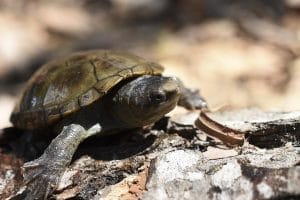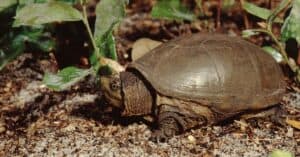Kinosternon acutum (Tabasco Mud Turtle)
Home > Turtle Database > Kinosternon acutum (Tabasco Mud Turtle)

The Tabasco Mud Turtle (Kinosternon acutum) is a small, freshwater turtle native to parts of Mexico and Central America. Recognized for its sharp-edged shell and secretive nature, this species plays a vital role in its aquatic ecosystems, contributing to the biodiversity of the regions it inhabits.
Native Turtle Species Map – Find Turtles by Region
Scientific Classification
- Kingdom: Animalia
- Phylum: Chordata
- Class: Reptilia
- Order: Testudines
- Family: Kinosternidae
- Genus: Kinosternon
- Species: K. acutum
Common Names
- Tabasco Mud Turtle
- Sharp-edged Mud Turtle
This Hilarious Turtle Book Might Know Your Pet Better Than You Do
Let’s be real—most turtle care guides feel like reading a textbook written by a sleep-deprived zookeeper.
This one’s not that.
Told from the snarky point of view of a grumpy, judgmental turtle, 21 Turtle Truths You’ll Never Read in a Care Guide is packed with sarcasm, sass, and surprisingly useful insights.
And hey—you don’t have to commit to the whole thing just yet.
Grab 2 free truths from the ebook and get a taste of what your turtle really thinks about your setup, your food choices, and that weird plastic palm tree.
It’s funny, it’s honest, and if you’ve ever owned a turtle who glares at you like you’re the problem—you’ll feel seen.
Identification
Description
The Tabasco Mud Turtle typically measures up to 15 cm (6 inches) in shell length. It has a dark brown to olive-colored carapace with sharp, serrated edges—a distinctive feature that sets it apart from other mud turtles. The plastron (the underside of the shell) is hinged, allowing the turtle to close its shell tightly for protection. Its skin is generally grayish, and it has a pointed snout with a slightly hooked upper jaw.
Sexual Dimorphism
Males usually have longer, thicker tails compared to females. Females tend to have a wider, more rounded carapace, while males may exhibit a slightly concave plastron to facilitate mating.
Check more turtles from the Kinosternon genus
Native Origin and Distribution
Geographical Range
The species is native to southeastern Mexico, primarily in the state of Tabasco, and extends into parts of Guatemala and Belize. It inhabits coastal lowlands and is often found near the Gulf of Mexico.
Preferred Habitat
The Tabasco Mud Turtle thrives in slow-moving freshwater environments such as swamps, marshes, ponds, and sluggish streams. It prefers areas with soft, muddy bottoms and abundant aquatic vegetation, which provide both food and shelter.
Behavior
Feeding Habits
An omnivorous species, it feeds on a variety of aquatic organisms, including insects, crustaceans, mollusks, and plant matter. It forages both in the water and on land, mainly during dawn and dusk hours.
Predators
Natural predators include larger fish, wading birds, and mammals that may prey on eggs, hatchlings, or occasionally adults. Human activities have also increased the risks due to habitat encroachment.
Reproduction
Breeding Season
Breeding typically occurs during the rainy season, from May to October, when water levels are higher and conditions are favorable for nesting.
Reproductive Method
The Tabasco Mud Turtle is oviparous. Females lay 2-4 eggs per clutch in nests dug into soft soil near water sources. Incubation lasts about 100-120 days, and hatchlings emerge during the wet season when food is abundant.
Conservation
Extinction Status
According to the International Union for Conservation of Nature (IUCN), the Tabasco Mud Turtle is classified as Near Threatened.
Threats
- Habitat Destruction: Agricultural expansion, deforestation, and urban development reduce available habitat.
- Pollution: Contamination of waterways from pesticides and industrial waste affects water quality.
- Pet Trade: Illegal collection for the pet industry diminishes wild populations.
Conservation Measures
- Protected Areas: Establishment of wildlife reserves within its natural range.
- Legal Protection: Enforcement of laws regulating trade and habitat destruction.
- Research and Monitoring: Ongoing studies to monitor population trends and ecological requirements.
Economic Importance
While not a major economic species, the Tabasco Mud Turtle is sometimes collected for the pet trade due to its manageable size and unique appearance. It may also have indirect economic value through its role in maintaining healthy aquatic ecosystems.
Interesting Facts
- The name “acutum” means “sharp” in Latin, referring to the turtle’s sharply edged shell.
- Its hinged plastron is an evolutionary adaptation that provides enhanced protection against predators.
- The species is relatively elusive, often burying itself in mud to avoid detection.

About Author
Muntaseer Rahman started keeping pet turtles back in 2013. He also owns the largest Turtle & Tortoise Facebook community in Bangladesh. These days he is mostly active on Facebook.














